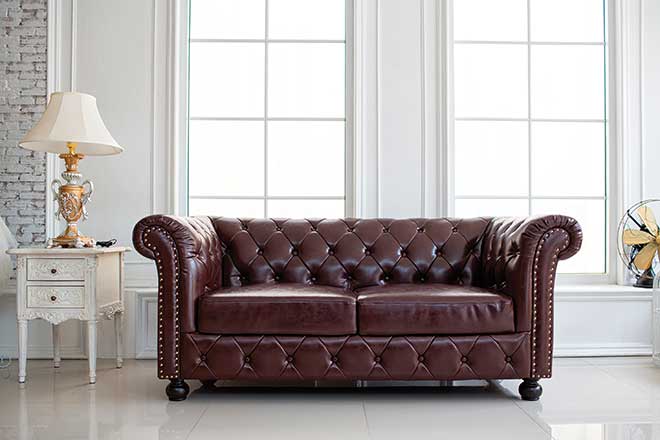It’s always interesting to see trends come and go. Younger designers often have little idea (or interest, sometimes) in where certain trends began. Take nailheads.
These have had a very long and storied past. On upholstery, the opinion of experts is that it all began with Louis XIII (1560-1643), with the creation of the os de mouton chair (which has legs resembling those of a sheep, or mouton). This was revolutionary (as were many things in France!), since it began the idea that upholstered backs and seats are acceptable. Here, nailheads were used not only to assist in keeping the fabric in place, but also to add a detail of beauty for the eye. Keep in mind that upholstery fabrics such as velvet, brocades, leather and tapestry were VERY expensive, and people did not just redo things lightly … even kings!
Across The Channel, during the Jacobean period (1603-1625), nailhead decoration was seen on wood furniture by the Dutch, English and Spanish. They had not caught on just yet to comfortable padded seating, but used the metal treatment to fancify their tables, chests and trunks. With very few exceptions, adding nailheads was a rather daft effort to create beauty on furniture that was so big and bulky it would certainly take more than a little metal to soften. But they at least tried.
Today, companies are adding nailheads in various finishes to once again adorn case goods. Now nailheads come in various sizes and shapes; until the 1880s they were square and rough. By adding these metal touches, a curved line can be accentuated or a Greek key pattern created for interest on the face of a cabinet. The possibilities are endless. No longer only utilitarian, the nailhead has punched its way into chic style!
Gracie was founded in 1898 by Charles R. Gracie and still is run by family members to this day. The carriage trade business is known today mainly for its exotic and beautifully designed hand-painted wallpapers, which adorn fine homes around the world. That division of the company began in the 1930s after a friend in the textile business returned from the Orient with a painted panel. Due to Mr. Gracie’s foresight and high-end clientele, the company has lead this part of the industry ever since.
Its product is manufactured both in New York and mainland China. During the Chinese revolution, the studio was moved to Taiwan in 1949 for a few decades but has since returned to the mainland. The same Chinese family has managed that division for more than 50 years!
Gracie began his business as a custom lamp maker, with a later foray into Asian antiques (which they still hand-select and offer). So it makes sense that hand-painted furniture would come into play at some point. For years the company has offered hand-painted coffee, console and side tables and lamps. Now chairs have been added to the collection.
This chinoiserie-styled chair comes in a variety of lacquer finishes, with hand-painted patterns. The perfect complement to a foyer or living room, these works of art are for anyone who loves beautiful things … like me!
Charlotte Moss China
What do you get when you match one of our country’s oldest fine china manufacturers, Pickard, with one of our country’s most famous tastemakers, Charlotte Moss? Something exceptional, of course!
This fine china company was founded in 1893 by Wilder Pickard and now is led by a fourth generation of the family. Each piece of tableware
goes through 21 stages of production, only to be inspected three times during the process by employees who average 18 years with the company. Each piece has some decoration in 24kt. gold, which enhances its beauty and value. They have produced designs for heads of state, as well as for foreign dignitaries.
Charlotte Moss founded her design company in 1985 and has since expanded her talents to design household goods for a number of companies, including Brunschwig & Fils and Traditions. Her keen eye is always on the hunt for what will stimulate the consumer next.
Her partnership with Pickard has spawned 10 different patterns, each with its own style, oftentimes inspired by previous tastemakers such as Elsie de Wolfe and Nancy Lancaster. Her first collection included Elsie, Espalier, Nancy and South Hampton. Her most recent launch is a bit broader, with Pagoda, Pineapple, Quail, Shell, Stag and Topiary. Most five-piece placesettings retail for around $375.
